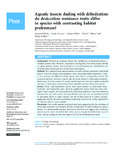Aquatic insects dealing with dehydration: do desiccation resistance traits differ in species with contrasting habitat preferences?
| dc.contributor.author | Pallarés, S | |
| dc.contributor.author | Velasco, J | |
| dc.contributor.author | Millán, A | |
| dc.contributor.author | Bilton, David | |
| dc.contributor.author | Arribas, P | |
| dc.date.accessioned | 2016-11-29T11:43:39Z | |
| dc.date.available | 2016-11-29T11:43:39Z | |
| dc.date.issued | 2016-08-31 | |
| dc.identifier.issn | 2167-8359 | |
| dc.identifier.issn | 2167-8359 | |
| dc.identifier.other | e2382 | |
| dc.identifier.uri | http://hdl.handle.net/10026.1/8045 | |
| dc.description.abstract |
Desiccation resistance shapes the distribution of terrestrial insects at multiple spatial scales. However, responses to drying stress have been poorly studied in aquatic groups, despite their potential role in constraining their distribution and diversification, particularly in arid and semi-arid regions.We examined desiccation resistance in adults of four congeneric water beetle species (Enochrus, family Hydrophilidae) with contrasting habitat specificity (lentic vs. lotic systems and different salinity optima from fresh- to hypersaline waters). We measured survival, recovery capacity and key traits related to desiccation resistance (fresh mass, % water content, % cuticle content and water loss rate) under controlled exposure to desiccation, and explored their variability within and between species.Meso- and hypersaline species were more resistant to desiccation than freshwater and hyposaline ones, showing significantly lower water loss rates and higher water content. No clear patterns in desiccation resistance traits were observed between lotic and lentic species. Intraspecifically, water loss rate was positively related to specimens' initial % water content, but not to fresh mass or % cuticle content, suggesting that the dynamic mechanism controlling water loss is mainly regulated by the amount of body water available.Our results support previous hypotheses suggesting that the evolution of desiccation resistance is associated with the colonization of saline habitats by aquatic beetles. The interespecific patterns observed in Enochrus also suggest that freshwater species may be more vulnerable than saline ones to drought intensification expected under climate change in semi-arid regions such as the Mediterranean Basin. | |
| dc.format.extent | e2382-e2382 | |
| dc.format.medium | Electronic-eCollection | |
| dc.language | en | |
| dc.language.iso | en | |
| dc.publisher | PeerJ | |
| dc.subject | Water content | |
| dc.subject | Coleoptera | |
| dc.subject | Lotic | |
| dc.subject | Water loss | |
| dc.subject | Cuticle | |
| dc.subject | Salinity | |
| dc.subject | Enochrus | |
| dc.subject | Lentic | |
| dc.subject | Inland salt water | |
| dc.subject | Drought | |
| dc.title | Aquatic insects dealing with dehydration: do desiccation resistance traits differ in species with contrasting habitat preferences? | |
| dc.type | journal-article | |
| dc.type | Journal Article | |
| plymouth.author-url | https://www.webofscience.com/api/gateway?GWVersion=2&SrcApp=PARTNER_APP&SrcAuth=LinksAMR&KeyUT=WOS:000383263900005&DestLinkType=FullRecord&DestApp=ALL_WOS&UsrCustomerID=11bb513d99f797142bcfeffcc58ea008 | |
| plymouth.issue | 8 | |
| plymouth.volume | 4 | |
| plymouth.publisher-url | https://peerj.com/ | |
| plymouth.publication-status | Published online | |
| plymouth.journal | PeerJ | |
| dc.identifier.doi | 10.7717/peerj.2382 | |
| plymouth.organisational-group | /Plymouth | |
| plymouth.organisational-group | /Plymouth/Faculty of Science and Engineering | |
| plymouth.organisational-group | /Plymouth/Faculty of Science and Engineering/School of Biological and Marine Sciences | |
| plymouth.organisational-group | /Plymouth/REF 2021 Researchers by UoA | |
| plymouth.organisational-group | /Plymouth/REF 2021 Researchers by UoA/UoA07 Earth Systems and Environmental Sciences | |
| plymouth.organisational-group | /Plymouth/Research Groups | |
| plymouth.organisational-group | /Plymouth/Research Groups/Marine Institute | |
| plymouth.organisational-group | /Plymouth/Users by role | |
| plymouth.organisational-group | /Plymouth/Users by role/Academics | |
| dc.publisher.place | United States | |
| dcterms.dateAccepted | 2016-07-30 | |
| dc.identifier.eissn | 2167-8359 | |
| dc.rights.embargoperiod | Not known | |
| rioxxterms.versionofrecord | 10.7717/peerj.2382 | |
| rioxxterms.licenseref.uri | http://www.rioxx.net/licenses/all-rights-reserved | |
| rioxxterms.licenseref.startdate | 2016-08-31 | |
| rioxxterms.type | Journal Article/Review | |
| plymouth.oa-location | https://peerj.com/articles/2382/ |


